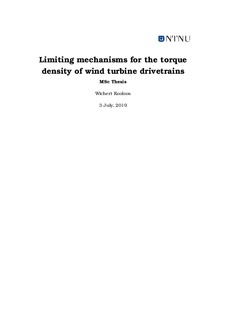| dc.description.abstract | As wind turbines continue to increase in size, so do the loads acting on the drivetrain.
To handle the higher loads the mass of the drivetrain needs to increase. A better understanding
of this mass increase can result in lighter drivetrain design and provide
an insight which drivetrain design has the lowest mass potential for large rotor diameters.
In this thesis the limiting mechanisms, mass and torque density of three
wind turbine drivetrains are investigated for an increasing rotor diameter. The limiting
mechanisms in this thesis provide a theoretical limit to the minimum required
mass of a drivetrain for increased loading. Through an extensive literature study the
limiting mechanisms are found and three scaling models are developed to calculate
the torque density of the drivetrains. The drivetrains that are being considered in this
thesis are the drivetrain with gearbox and high-speed generator, the direct drivetrain
and the hydraulic drivetrain. The following research questions are answered in this
thesis:
• What are the limiting mechanisms of the three investigated drivetrain types?
• What are the achievable torque densities of the three investigated drivetrain
configurations for increasing rotor diameters?
Two limiting mechanisms are found for the drivetrain with gearbox and high-speed
generator: Tooth flank stress (1.72 GPa) and Root bending stress (0.24 GPa). The
Tooth flank stress is found to be governed by the Hertzian contact strength while the
root bending stress is governed by the flexural strength. Two limiting mechanisms
for the RFPMSG are found for the airgap flux density (1 T) and the current loading
(30 - 200 kA/m) in the generator windings. The airgap flux density is limited by the
saturation of the stator teeth material in the generator whereas the current loading
is limited by the heat dissipation of the windings and stator laminations. For the
hydraulic pump, the limiting mechanism is found at the interaction of the camring
and the cam roller. The maximum stress that is allowed at this point is determined
by the Hertzian contact strength of the material and is found to be (1.72 GPa). Using
the limiting mechanisms of the three drivetrain configurations, scaling models for
the mass and torque density of the three drivetrains have been developed. | |
